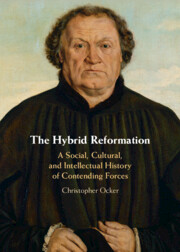Book contents
- The Hybrid Reformation
- The Hybrid Reformation
- Copyright page
- Additional material
- Dedication
- Contents
- Preface
- Part I Indifference and Ambiguity
- Part II Medieval Protestants
- Part III Interpretation beyond Borders
- 7 Erasmus and Biblical Scholasticism
- 8 A Literal Incident, a Spiritual Menace
- 9 The Trouble with Allegory
- 10 Third Forces in a Hybrid Reformation
- Bibliography
- Index
8 - A Literal Incident, a Spiritual Menace
Calvin versus Castellio and Libertines
from Part III - Interpretation beyond Borders
Published online by Cambridge University Press: 30 September 2022
- The Hybrid Reformation
- The Hybrid Reformation
- Copyright page
- Additional material
- Dedication
- Contents
- Preface
- Part I Indifference and Ambiguity
- Part II Medieval Protestants
- Part III Interpretation beyond Borders
- 7 Erasmus and Biblical Scholasticism
- 8 A Literal Incident, a Spiritual Menace
- 9 The Trouble with Allegory
- 10 Third Forces in a Hybrid Reformation
- Bibliography
- Index
Summary
A reformer tried to build religious community by preaching the word of God and subjecting the town and territory to the pastoral oversight of evangelical clergy. To preach and reorganize, the reformer needed a bible that recounted events and narratives written down for an explicit purpose: the regeneration of individual and society. The reformer was sensitive to threats to the bible’s purpose. Any time textual fact and regenerative purpose seemed to drift apart, its purpose could seem to be compromised. Fact and purpose could drift apart in two ways. Historicizing the text, taking the book as the artifact of a distinctive, remote culture or as ancient fiction, could seem to nullify the text’s power as divine speech in the present. Equally problematic was the suggestion that spiritual readings of the text were divorced from historical facts. These two challenges to the bible, one historicizing and another spiritualizing, first appeared as an intellectual dilemma in the Reformation. This chapter illustrates that first appearance by examining two controversies in the life of the Reformation’s most celebrated literalist, John Calvin. The first example is Calvin’s conflict with his friend Sebastian Castellio. The second is Calvin’s conflict with the so-called “libertines.”
Keywords
- Type
- Chapter
- Information
- The Hybrid ReformationA Social, Cultural, and Intellectual History of Contending Forces, pp. 185 - 200Publisher: Cambridge University PressPrint publication year: 2022

